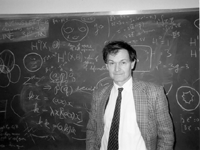
Sir Roger Penrose, was born in England, in Colchester, August 8, 1931. His parents were both highly educated. His mother Margaret Feathe was a doctor, and his father, Lionel Sharples Penrose, was a medical geneticist. He and his brothers Oliver and Jonathan all went into the sciences. Jonathan became a psychologist, while Oliver, the eldest, became a mathematician. Roger was groomed to be a doctor, but he swerved into another path when his school would not let him have biology, and mathematics as his focuses. He was allowed two, and he could not give up math. Needless to say, his parents were wroth with him for a time for disrupting their plans, but he went on to graduate from University College London with a bachellor of sciences in mathematics, winning First Class honors.
He later became interested in physics, through the inspiration of Dirac, Turing and Godel. He attended their lectures at Cambridge and found them fascinating. However, he continued his works in mathematics, receiving a Ph.D in Algebraic Geometry. He is famous for his aperiodic tilings, his collaboration with Stephen Hawking on black holes, and especially for his books on consciousness such as The Emporer's New Mind. A less-well-known achievement on his part was the development of twistor geometry, a concept that will be explained in further depth later on.
Queerly, everyone in mathematics and physics has heard of him, and every dabbler in puzzles and games has probably used his tilings. Many in England have probably even wiped with toilet paper bearing the pattern named after him. Yet he is not published in any standard biography of 20th century greats, he is known largely only by book reviews or in conjunction with Stephen Hawking. His personal life is closed off--all I found was some gossip that he had recently had a child with his wife (presumably, eh?) in his 60s, and that that wife's name was Vanessa Thomas, a consultant specializing in Mathematica teaching programs and how to use them. This after three hours searching newspapers, magazines, EBSCOhost and online resources.
Yet he is regarded with awe in my circle of physics majors, his anti-AI books prompted ant anti-programming group based in Sweden to name themselves after him, and he has done research on fiundamental issues in physics today.
Penrose is generally termed gentle. His handwriting is rounded and soft, similar to a childs loopy writing. An interview with him in Japan reveals a contemplative nature as he describes art that he and his wife encountered there. What I find remarkable is that he is known as a physicist despite the fact that his primary ecucation background is in mathematics, which only goes to prove a pet argument of mine, I suppose. Physics today is really high-order mathematics that corresponds to the real world. Thus even the most abstract of mathematics finds a use to describe a portion of our universe. For example, Roger Penrose's aperiodic tilings are found to be similar to the crystalline formations of some substances. A company has used the tiling to create a better no-stick-coating for pots and pans.